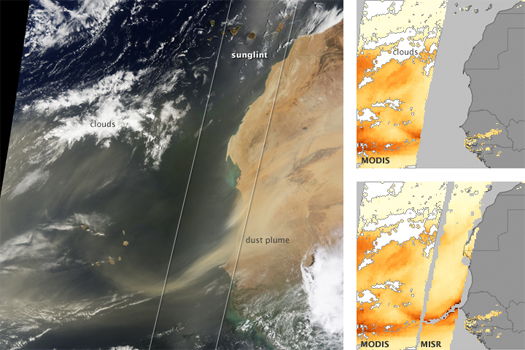
[The future soil of Miami, captured by satellites while drifting off the coast of Africa.]
At InfraNet Lab, Mason White posts about “Particulate Swarms”, or three storm typologies: dust, water, and gas. The first image in the post, of a dust storm over Sydney, reminds me (because in my haste, I mistakenly read the form of the storm as penisular Florida) of an extraordinary passage from Marq De Villiers’ natural history of the Sahara, which is rather unimaginatively titled Sahara:
…Dust from North Africa is commonly found in England and northern Germany, as well as in France.
In 1989, the winds were so strong that fully grown grasshoppers were carried across the Atlantic from the Sahel, to be dropped on the canefields and beaches of Antigua five days later. In the last year of the millennium a reddish-brown river of dust, picked up from the deserts and eroding grazing lands of the Sahel, a plume hundreds of miles wide and thousands long, was whipped across the Atlantic by the trade winds. Planetary ecologists say somewhere between 60 million and a billion tons of the Sahara’s iron-rich sand blows across the Atlantic each year, an estimate, obviously, with a fair degree of elasticity… the number has been going up steadily over the past twenty-five years, and at the same time, the mortality rate of creatures like Caribbean coral has risen sharply. Eugene Shinn, a researcher with the U.S. Geological Survey in St. Petersburg, Florida, has tracked the coral’s declining health to fungal spores and bacterial cysts hitching a ride on African sand; in 1998, scientists identified an African soil fungus as the cause of the decimation of sea fans across the entire Caribbean, an object lesson in the interconnectedness of life.
The dust is also now known to be bringing traces of pesticides banned in the United States but still used in Africa, such as chlordane and DDT, back to American shores. This African dust is not universally harmful–orchids growing in the upper canopy of the Amazon rain forest actually depend on it for proportion of their nutrients–but it is generally worrisome.
Another U.S. Geological Survey report in 2001 said that what the researchers called “opportunistic pathogens” were hitching rides from Africa on the wind–the sand is heavy enough that the dust clouds block enough solar radiation to protect bacteria on their journey to the New World. Large dust arrivals from Africa have now been found over 30 percent of the continental United States; although no one has yet estimated its mass, it would be a small fraction of the amount that leaves the Sahara. About half the volume that reaches the United States settles on Florida. On any given day, a third to a half of the dust drifting through Miami comes not from local beaches but from Africa. “It may”, the study suggested, “pose a significant public health threat.”

